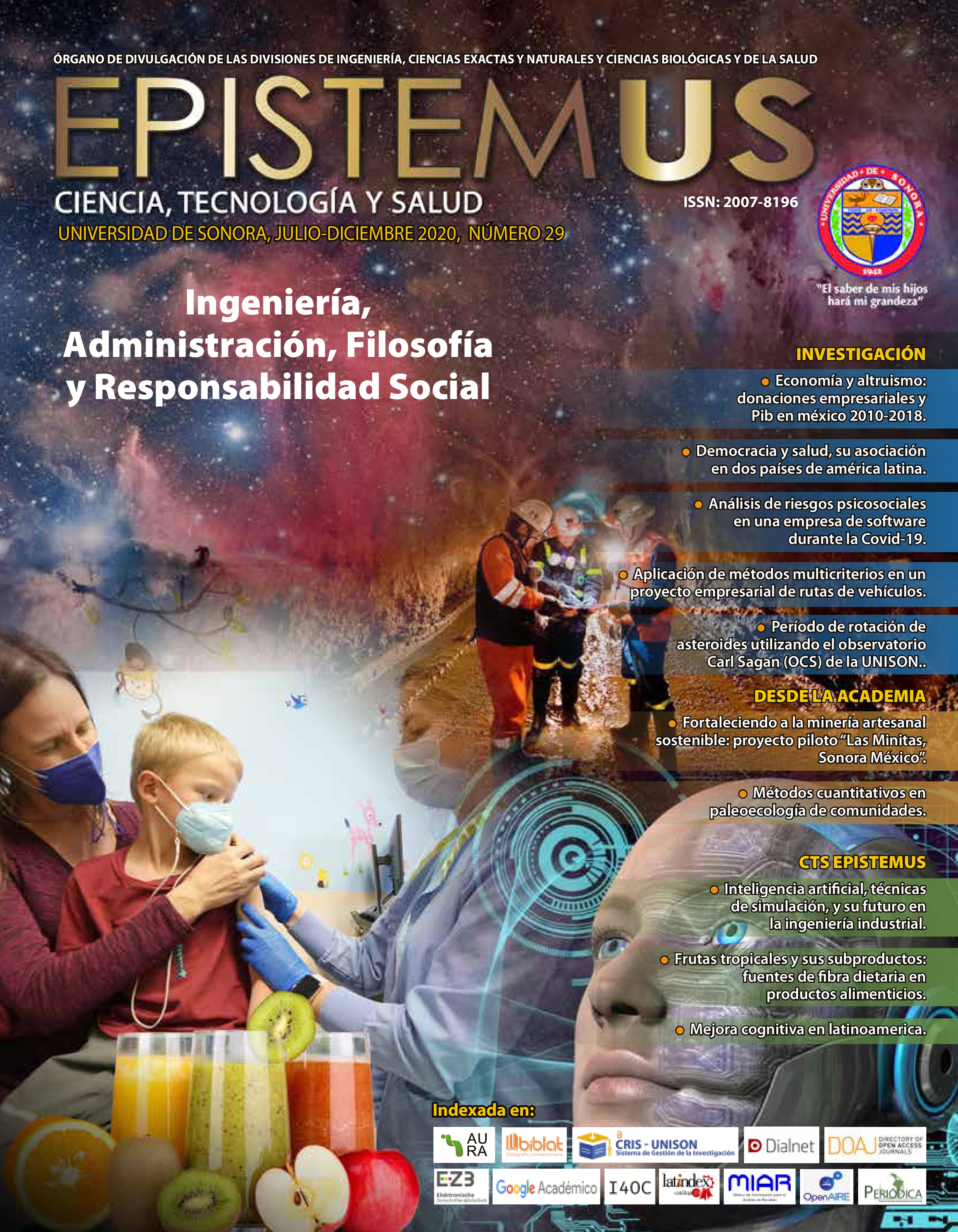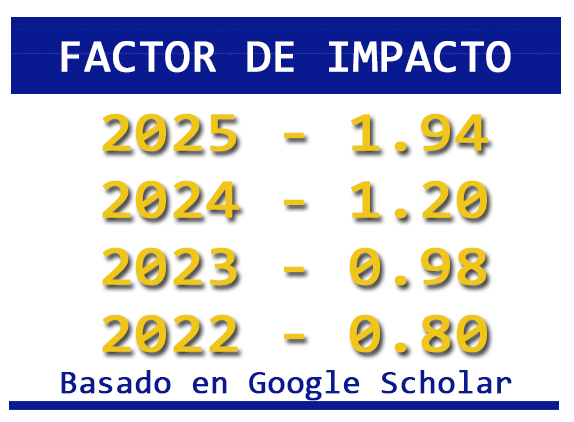Quantitative methods in community paleoecology
DOI:
https://doi.org/10.36790/epistemus.v14i29.138Keywords:
Paleoecology, paleocommunities, ecological indicesAbstract
This work describes the most common quantitative methods for the general characterization of paleocommunities from a given site and proposes a quick and simple guide that includes the main indicators used in paleoecology. The sequence combines the following attributes: 1) collecting, identifying, and quantifying paleontological material, 2) estimating spatial patterns, 3) determining species diversity through ecological indicators, rarefaction methods, as well as compositional, similarity, and differentiation coefficients. This stepwise progression finally results in the recognition of attributes such as number and relative abundance of species, the nature of their interactions and the physical structure of communities. The knowledge of the ecological changes taken in the past not only improves our understanding and management of current ecosystems, but also helps to predict and elaborate educated guesses about possible future changes in one or several attributes or parameters.
Downloads
References
E.P. Odum, G.W. Barrett. Fundamentals of Ecology, 5th ed.: Belmont, CA, Thomson Brooks/Cole, pp. 598, 2005.
J.S. Lewis, M.L. Farnsworth, C.L. Burdett, D.M. Theobald, D.M. Gray, R.S. Miller, “Biotic and abiotic factors predicting the global distribution and population density of an invasive large mammal”, Scientific Reports, vol. 7, pp. 1–12, March 2017. DOI: https://doi.org/10.1038/srep44152
A.W.R. Seddon, A.W. Mackay, A.G. Baker, H.J.B. Birks, E. Breman, C.E. Buck, E.C. Ellis, C.A. Froyd, J.L. Gill, L. Gillson, E.A. Johnson, V.J. Jones, S. Juggins, M. Macias‐Fauria, K. Mills, J.L. Morris, D. Nogués‐Bravo, S.W. Punyasena, T.P. Roland, A.J. Tanentzap, K.J. Willis, M. Aberhan, E.N. van Asperen, W.E.N. Austin, R.W. Battarbee, S. Bhagwat, C.L. Belanger, K.D. Bennett, H.H. Birks, C. Bronk-Ramsey, S.J. Brooks, M. de Bruyn, P.G. Butler, F.M. Chambers, S.J. Clarke, A.L. Davies, J.A. Dearing, T.H.G. Ezard, A. Feurdean, R.J. Flower, P. Gell, S. Hausmann, E.J. Hogan, M.J. Hopkins, E.S. Jeffers, A.A. Korhola, R. Marchant, T. Kiefer, M. Lamentowicz, I. Larocque‐Tobler, L. López‐Merino, L.H. Liow, S. McGowan, J.H. Miller, E. Montoya, O. Morton, S. Nogué, C. Onoufriou, L.P. Boush, F. Rodriguez‐Sanchez, N.L. Rose, C.D. Sayer, H.E. Shaw, R. Payne, G. Simpson, K. Sohar, N.J. Whitehouse, J.W. Williams, A. Witkowski, “Looking forward through the past: identification of 50 priority research questions in palaeoecology”, Journal of Ecology, vol. 102, no. 1, pp. 256–267, January 2014. DOI: https://doi.org/10.1111/1365-2745.12195
D. Fraser, L.C. Soul, A.B. Tóth, M.A. Balk, J.T. Eronen, S. Pineda-Munoz, A.B. Shupinski, A. Villaseñor, W.A. Barr, A.K. Behrensmeyer, A. Du, J.T. Faith, N.J. Gotelli, G.R. Graves, A.M. Jukar, C.V. Looy, J.H. Miller, R. Potts, S.K. Lyons, “Investigating Biotic Interactions in Deep Time”, Trends in Ecology & Evolution, vol. 36, no. 1, pp. 61-75, October 2020. DOI: https://doi.org/10.1016/j.tree.2020.09.001
H.A. Noriega-Ruiz, “Litofacies, microfacies y biofacies del Cámbrico del área El Sahuaral, Sonora central: consideraciones paleoecológicas y paleogeográficas”. Tesis de Maestría en Ciencias-Geología, Universidad de Sonora, Sonora, México, 2019.
D.A. Croft, D.F Su, S.W. Simpson, Methods in Paleoecology: Reconstructing Cenozoic Terrestrial Environments and Ecological Communities, Vertebrate Paleobiology and Paleoanthropology, Springer Nature Switzerland, 2018. DOI: https://doi.org/10.1007/978-3-319-94265-0
S.T., Jackson, J.L. Blois, Community ecology in a changing environment: Perspectives from the Quaternary, Proceedings of the National Academy Sciences of the United States of America vol. 112, no. 16, pp. 4915-4921, April 2015.
D.R. Foster, P.K. Schoonmaker, S.T.A. Pickett, “Insights from paleoecology to community ecology”. Trends in ecology & evolution, vol. 5, no. 4, pp. 119-122, April 1990. DOI: https://doi.org/10.1016/0169-5347(90)90166-B
J.B. Bennington, W.A. Dimichele, C. Badgley, R.K. Bambach, P. M. Barrett, A.K. Behrensmeyer, R. Bobe, R.J. Burnham, E.B. Daeschler, J.V. Dam, J.T. Eronen, D.H., Erwin, S. Finnegan, S.M. Holland, G. Hunt, D. Jablonski, S.T. Jackson, B.F. Jacobs, S.M. Kidwell, P.L. Koch, M.J. Kowalewski, C.C. Labandeira, C.V. Looy, S.K. Lyons, P.M. Novack-Gottshall, R. Potts, P.D. Roopnarine, C.A.E. Strömberg, H.D. Sues, P.J. Wagner, P. Wilf, S.L. Wing, “Critical issues of scale in paleoecology”, Palaios, vol. 24, pp. 1-4. DOI: https://doi.org/10.2110/palo.2009.S01
C.E. Brett, "Paleoecology", in AccessScience, ©McGraw-Hill Companies, 2008.
J. Ludwig, J. Reynolds, Statistical ecology. A primer on methods and computing, A Wiley-Interscience publication, John Wiley & Sons, Inc., pp. 107-144, 2008.
T.M. Smith, R.L. Smith, Ecología. 6a Edición., S.A. Madrid, Pearson Educación, 2007.
W.J. Sutherland, E. Fleishman, M.B. Mascia, J. Pretty, M.A. Rudd, “Methods for collaboratively identifying research priorities and emerging issues in science and policy”, Methods in Ecology and Evolution, vol. 2, pp. 238–247, 2011. DOI: https://doi.org/10.1111/j.2041-210X.2010.00083.x
G.E. Hutchinson, “The Concept of Pattern in Ecology”, Proceedings Academy Natural Sciences of Philadelphia, vol. 105, pp. 1-12, 1953.
L. de Bonis, G. Bouvrain, D. Geraads, G. Koufos, “Diversity and paleoecology of Greek late Miocene mammalian faunas“, Palaeogeography, Palaeoclimatology, Palaeoecology, Elsevier Science Publishers B. V., vol. 91, no. 1-2, pp. 99-121, 1992. DOI: https://doi.org/10.1016/0031-0182(92)90035-4
A.E. Magurran, Ecological diversity and its measurement, Princeton University Press, New Jersey, 1988. DOI: https://doi.org/10.1007/978-94-015-7358-0
C.E., Moreno, Métodos para medir la biodiversidad. 1ª edición, Manuales y tesis de la Sociedad Entomológica Aragonesa (SEA), Zaragoza, 2001.
E.H. Simpson, “Measurement of the diversity”, Nature, vol. 163, no. 4148, pp. 688, 1949.
C.E. Shannon, “A mathematical theory of communication”. The Bell system technical journal, vol. 27, no. 3, pp. 379-423, 1948. DOI: https://doi.org/10.1002/j.1538-7305.1948.tb01338.x
E.F. Menhinick, “A Comparison of Some Species‐Individuals Diversity Indices Applied to Samples of Field Insects”, Ecology, vol. 45, no. 4, pp. 859-861, October 1964. DOI: https://doi.org/10.2307/1934933
A. Chao, “Species estimation and applications”, Encyclopedia of Statistical Sciences, 2nd Edition, vol. 12, pp. 7907–7916, 2005.
H.L. Sanders, “Marine benthic diversity: a comparative study”, The American Naturalist, vol. 102, no. 925, pp. 243-282, May-June 1968. DOI: https://doi.org/10.1086/282541
S.H. Hulbert, “The non-concept of species diversity. A critique and alternative parameters”, Ecology, vol. 52, no. 4, pp. 577-586, April 1971. DOI: https://doi.org/10.2307/1934145
T.M. DeJong, “A comparison of three diversity indices based on their components of richness and evenness”, Oikos, vol. 26, no. 2, pp. 222-227, 1975. DOI: https://doi.org/10.2307/3543712
P.G. Risser, E.L. Rice, “Diversity in tree species in Oklahoma upland forests”, Ecology, vol. 52, no. 5, pp. 876-880, September 1971. DOI: https://doi.org/10.2307/1936036
Y. Loya, “Community structure and species diversity of hermatypic corals at Eilat, Red Sea”, Marine Biology, vol. 13, no. 2, pp. 100-123, 1972. DOI: https://doi.org/10.1007/BF00366561
C.H. Heip, P.M. Herman, K. Soetaert, “Indices of diversity and evenness”, Océanis, vol. 24, no. 4, pp. 61-87, 1998.
E.C. Pielou, The interpretation of ecological data: a primer on classification and ordination. A Wiley-Interscience Publication, John Wiley & Sons, Inc., New York, 1984.
L. Jost, A. Chao, R.L. Chazdon, Compositional similarity and beta diversity, in Biological diversity: frontiers in measurement and assessment (Magurran, A.E. and McGill, B.J., eds.), Oxford University, Chapter 6, pp. 66-76, January 2011.
P. Jaccard, “Nouvelles recherches sur la distribution florale”, Bulletin de la Société Vaudoise des Sciences Naturelles, vol. 44, no. 163, pp. 223-270, 1908.
E. Soler, P. Berroterán, J. Gil, R. Acosta, “Índice valor de importancia, diversidad y similaridad florística de especies leñosas en tres ecosistemas de los llanos centrales de Venezuela”, Agronomía Tropical, vol. 62, no. 1-4, pp. 25-38, 2012.
T.J. Sørensen, “A method of establishing groups of equal amplitude in plant sociology based on similarity of species content and its application to analyses of the vegetation on Danish commons”, Biologiske Skrifter/Kongelige Danske Videnskabernes Selskab, Copenhagen: Munksgaard, vol. 5, pp. 1-34, 1948.
B.D. Coleman, “On random placement and species-area relations”, Mathematical Biosciences, vol. 54, no. 3-4, pp. 191-215, June 1981. DOI: https://doi.org/10.1016/0025-5564(81)90086-9
F.J. Cuen-Romero, J.E. Valdez-Holguín, B.E. Buitrón-Sánchez, R. Monreal, L.F. Enríquez-Ocaña, E.A. Hinojosa, J.A. Ochoa-Granillo, F.J. Grijalva-Noriega, J.J. Palafox Reyes, “Paleoecology of Cambrian communities of central Sonora, Mexico: Paleoenvironmental and biostratigraphic considerations”, Journal of South American Earth Sciences, 92, pp. 631-645, April 2019. DOI: https://doi.org/10.1016/j.jsames.2019.04.005
Ø. Hammer, D. Harper, P. D. Ryan, “Past: paleontological statistics software package for education and data analysis”, Paleontologia Electronica, vol. 4, no. 1, art. 4, pp. 1-9, June 2001.
Downloads
Published
How to Cite
Issue
Section
License
Copyright (c) 2021 EPISTEMUS

This work is licensed under a Creative Commons Attribution-NonCommercial-NoDerivatives 4.0 International License.
The magazine acquires the patrimonial rights of the articles only for diffusion without any purpose of profit, without diminishing the own rights of authorship.
The authors are the legitimate owners of the intellectual property rights of their respective articles, and in such quality, by sending their texts they express their desire to collaborate with the Epistemus Magazine, published biannually by the University of Sonora.
Therefore, freely, voluntarily and free of charge, once accepted the article for publication, they give their rights to the University of Sonora for the University of Sonora to edit, publish, distribute and make available through intranets, Internet or CD said work, without any limitation of form or time, as long as it is non-profit and with the express obligation to respect and mention the credit that corresponds to the authors in any use that is made of it.
It is understood that this authorization is not an assignment or transmission of any of your economic rights in favor of the said institution. The University of Sonora guarantees the right to reproduce the contribution by any means in which you are the author, subject to the credit being granted corresponding to the original publication of the contribution in Epistemus.
Unless otherwise indicated, all the contents of the electronic edition are distributed under a license for use and Creative Commons — Attribution-NonCommercial-ShareAlike 4.0 International — (CC BY-NC-SA 4.0) You can consult here the informative version and the legal text of the license. This circumstance must be expressly stated in this way when necessary.
The names and email addresses entered in this journal will be used exclusively for the purposes established in it and will not be provided to third parties or for their use for other purposes.















